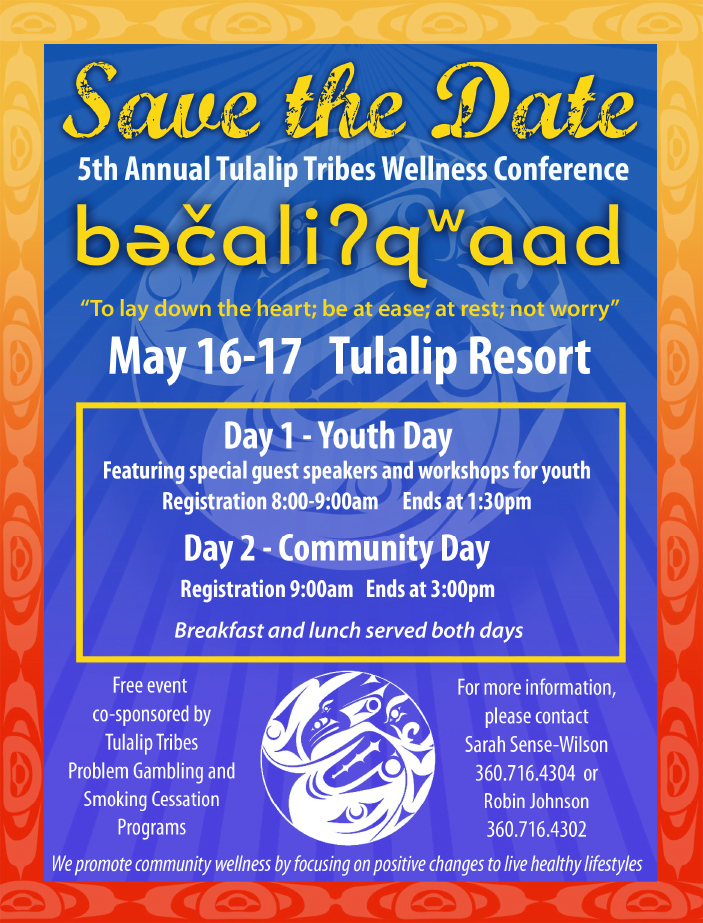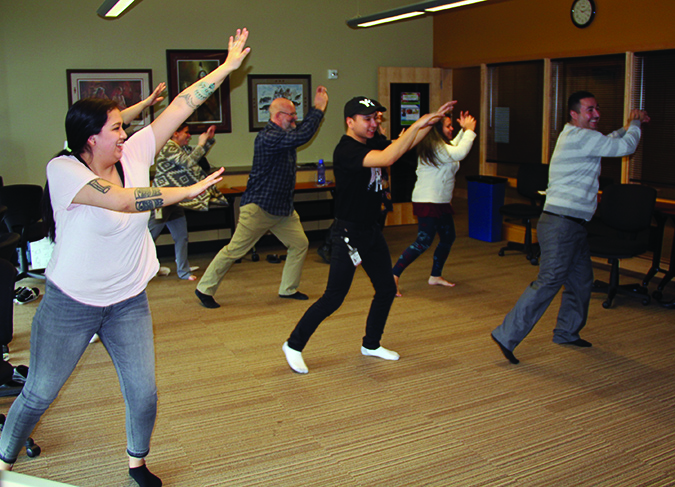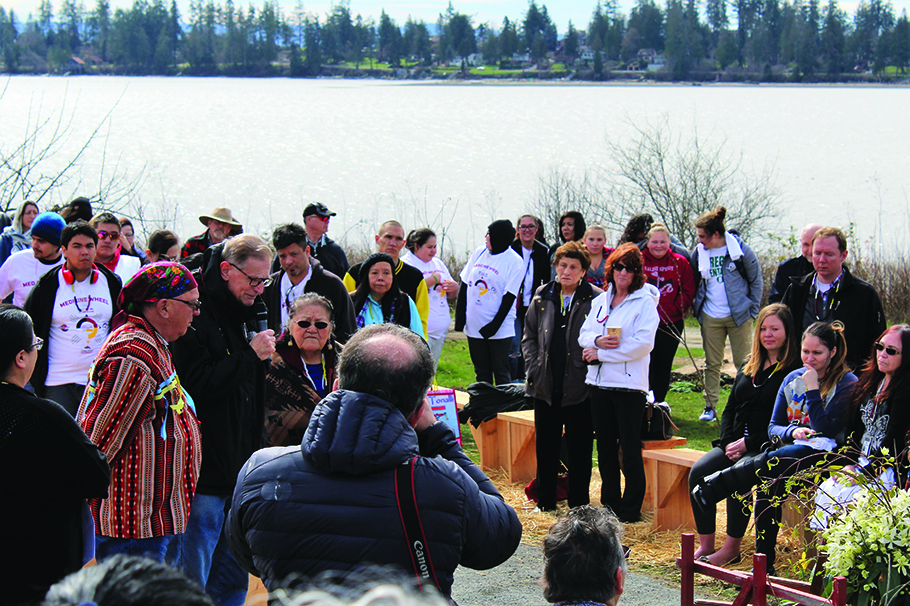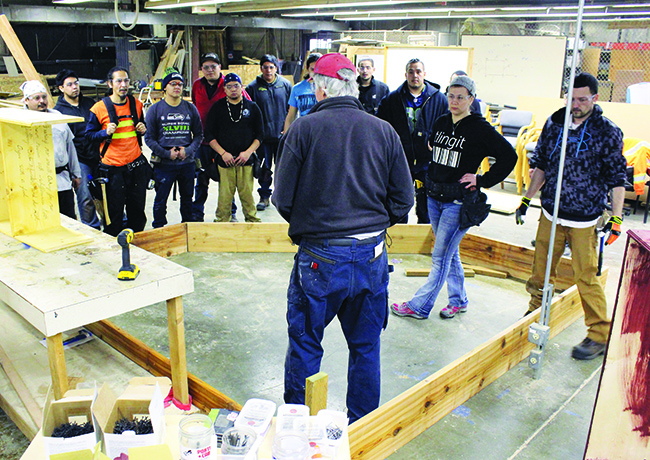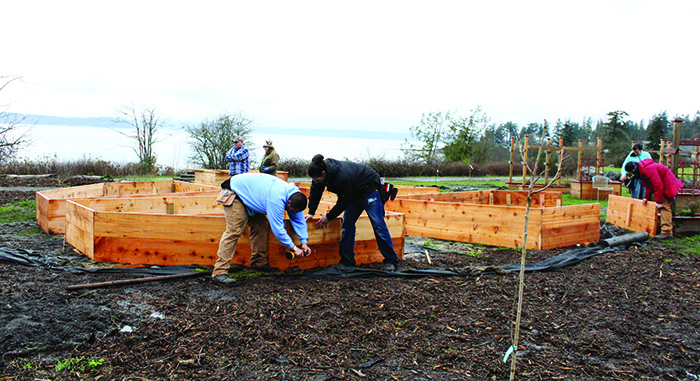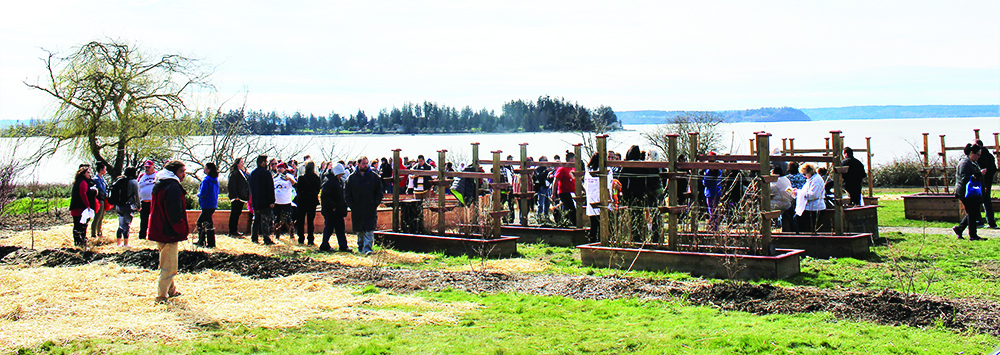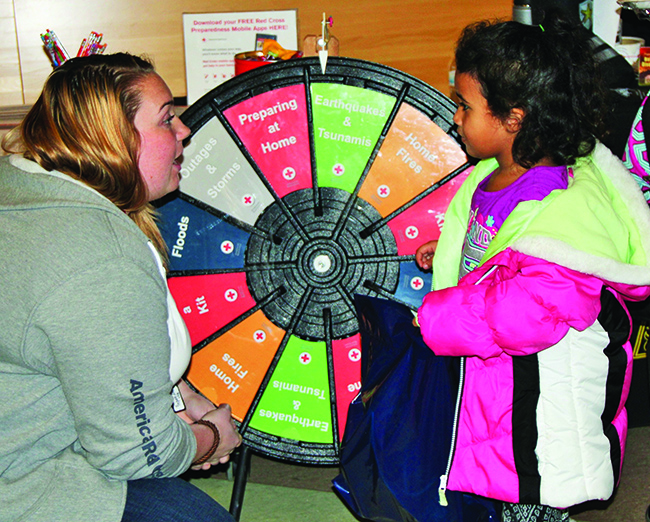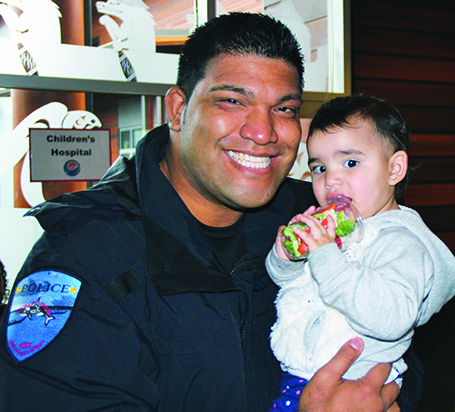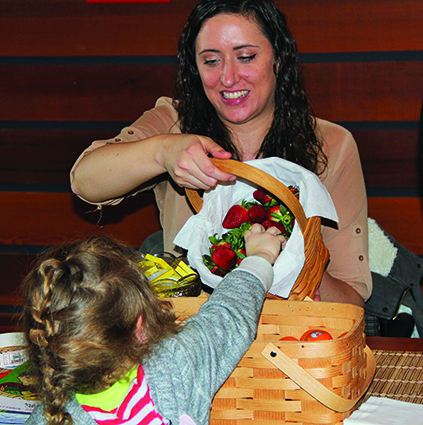Category: Health
A New Vision for Tulalip: Everett Optometry Clinic Opens at Karen I. Fryberg Health Clinic

By Kalvin Valdillez, Tulalip News
The Tulalip Tribes recently welcomed the Everett Optometry Clinic, this past November, to a new office located at the Karen I. Fryberg Health Clinic. For the past forty years, Everett Optometry has provided eye care services to Snohomish county residents. With numerous positive online reviews, the optometry clinic is a favorite among locals of the Everett area. By bringing their friendly customer service and making accountability top priority, Everett Optometry looks forward to a new outlook in eye care for the Tulalip community.
Eye health is often overlooked. In today’s society of constantly switching between phone, tablet, computer and TV screens it is important to take care of your eyes and visit the optometrist for an annual exam. During a comprehensive eye exam, an optometrist can determine if a patient requires prescription glasses or contact lenses as well detect early signs of diseases such as glaucoma and cataracts.
Diabetes and high blood pressure, both major health concerns across Native America, can cause damage to the eye vessels, and if untreated can lead to complete vision loss. Everett Optometry works with the Tulalip Health Clinic’s medical professionals to provide the best possible care under one umbrella to individuals living with diabetes or high blood pressure.
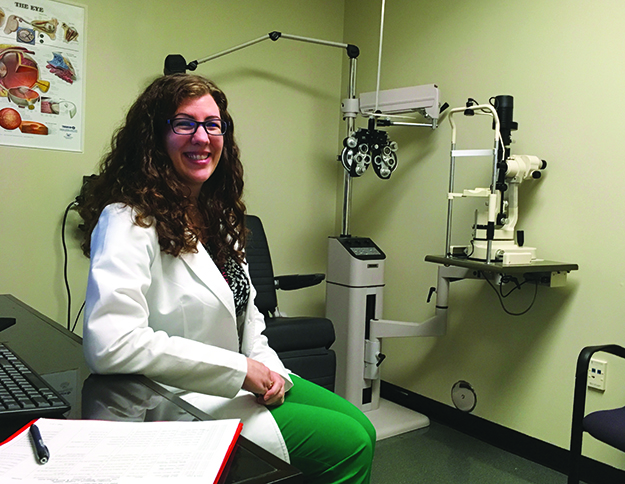
Optometric Physician, Dr. Rachel Spillane spoke of the importance of eye exams, “It’s just so critical at all ages, we are seeing everyone from two year-olds to ninety year-olds. Especially for kids right as they are entering school, we want to make sure they have the proper vision and their eyes are focusing properly so they will be able to learn.”
Children who are nearsighted, vision that causes far away objects to appear blurry, are able to express their visual impairment and therefore can be treated. However, children who see objects in the distance clearly but have trouble seeing closer items, or farsighted, may not communicate that they are having difficulties seeing properly. For this reason, it is important to get children’s eyes checked at a young age, preferably before heading into school. During the eye chart test, when patients read letters out loud from a distance, Dr. Spillane provides fun shapes such as animals for the younger children who may not know their alphabet yet. The optometry clinic also takes the time to discuss proper usage and safety for glasses and contact lenses with children.
In some cases, parents opt to wait to take their children to the optometrist until they are older, preventing the child from unlocking their full potential in school.
“We’ve been finding a lot of kids that are a little further along, I’d say about second grade, they’re really struggling. Their teachers have labeled them as problem children because they’re not able to focus and pay attention. And then I’ll do their exam and find out they can’t see anything. But at that age they don’t say what’s wrong. As an adult we’ll say, I have a headache, or the words are going in and out [of focus]. Kids won’t, they’ll just quit and go do other things,” she stated.
The new office has state of the art technology allowing Dr. Spillane the ability to perform a majority of the procedures at the clinic, with a few exceptions including Lasik Laser eye surgery, which can be performed at the Colby Avenue location. The optometry clinic also sees patients for infections such as pink eye, as well as emergency situations like cuts or eye bleeding.
Dispensing Optician, Dianna Felgar, assists during the process of choosing the perfect pair of frames, lenses, and contact lenses for each patient. The new optometry clinic offers a variety of frames from over thirty brands including Oakley, Ray Ban, Dolce & Gabana, Maui Jim, and the Native American eyewear company Aya.
Qualified patients may receive additional financial assistance through Tulalip’s Patient Assistance program. Gloria Beal, Paraoptometric at the clinic, works with finance and insurance companies to ensure the patient is receiving the funding they are eligible for, therefore allowing them to receive the care they require.
Currently the Everett Optometry Clinic is open on Tuesdays and Thursdays between the hours of 8:00 a.m. and 5:00 p.m. However, through an office cell phone where voicemail and text messages are encouraged, they are available to the Tulalip community at all times. Patients can also be seen Monday-Friday at the Everett location.
For additional information please contact (360) 716-4511, visit www.everettoptometry.com, or call/text their office cell phone (425) 314-1312.
In the Kitchen with Quinoa
Article and photo by Kalvin Valdillez
The word about Wellness Wednesday is spreading throughout the Tulalip community. Hosted by SNAP-ED every Wednesday at 2:00 p.m. at the Tulalip Administration Building, the event alternates weekly between live-cooking demonstrations and quick and effective workout regimens to promote healthy lifestyle choices for the busy workaholics with full schedules.
During the last week of March, SNAP-ED Coordinator AnneCherise Jensen whipped up a delicious southwest quinoa dish, to much approval from the Wellness Wednesday participants. AnneCherise shares the many benefits of quinoa as well as the southwest quinoa recipe. Enjoy!
Quinoa: Quinoa is one of the oldest grains and has been around for centuries! Its history traces back to South America and South Africa, and has only been introduced to the United States as a “super food” within the last decade.
Quinoa is especially healthy because it is high in protein, healthy fats, insoluble fiber and various vitamins and minerals.
Protein: Amino acids are the building blocks of proteins, and proteins are the building blocks of all tissues in our body. Some of the amino acids are referred to as “essential” because of our body’s inability to produce them, making it essential to acquire them from the diet. Quinoa contains more protein than both corn and brown rice, making it an excellent source of plant based protein. Quinoa is even considered a “complete” protein source, meaning it provides all the essential amino acids needed in our diet. For those who are vegetarian or vegan, Quinoa is an excellent way to get an adequate amount of protein through your diet.
Fat: Quinoa contains healthy fats, such as omega-3’s and omega-6’s that are extremely heart healthy! Consuming a diet high in omega-3’s and omega-6’s help lower bad cholesterol and prevents against heart disease.
Carbohydrates: Quinoa contains more fiber than brown rice. Quinoa is an excellent source of insoluble fibers which are great for keeping you fuller longer, keeping you regular, and can even help you lose weight.
Vitamins & Minerals: Quinoa is a good source of antioxidants and minerals, providing more magnesium, iron, fiber and zinc than many common grains.
How to COOK with Quinoa: Quinoa is easy to cook! It’s the same procedure as rice. Boil two cups of water for every 1 cup of dry quinoa. Add quinoa to boiling water; simmer heat with lid for 10-15 minutes until water is fully absorbed. Once it’s cooked, the possibilities are endless!
- Quinoa is mild in flavor, and is a great addition to any salad! Quinoa adds texture and an overall higher nutrient profile to any fruit or vegetable salad.
- Quinoa is a great main ingredient for any casserole!
- Quinoa is great in stir fry’s! Just substitute the rice in any of your favorite dishes!
- Add quinoa to your morning egg scramble or omelet for even more super fuel!
- Try baked Stuffed Peppers with Quinoa and your favorite protein!
- Bake with it! Add some quinoa to your zucchini, banana and carrot bread for extra health benefits!
- Make it into a snack! Try Peanut Butter Quinoa Balls – only 2 ingredients, Peanut butter and Quinoa. Great after school snacks for your kids!
Southwest Quinoa
Ingredients
- 1 Avocado
- 1 (15-ounce) can Black beans
- ½ cup Cilantro, fresh leaves
- 1 cup Corn, canned or roasted frozen kernels
- 2 cloves Garlic
- 1 Onion
- 1 Lime, Juice of
- 1 (14.5 oz.) can Tomatoes,
- 1 cup Quinoa
- 1 tsp Chili powder
- 1 tsp. salt & black pepper
- 1/2 tsp Cumin
- ½ tsp. garlic salt
- 1 tbsp. Olive oil or Canola oil
- 1 cup shredded cheese (optional)
Directions
- Precook quinoa in a separate pan. Boil two cups water for one cup quinoa; simmer heat to low after adding in quinoa. Let sit until water is fully absorbed.
- Heat olive oil in a large skillet over medium high heat. Sauté’ garlic and onion, stirring frequently until fragrant, about 1 minute.
- Add in drained and rinsed beans, tomatoes, corn, chili powder, cumin and garlic powder into large skillet; season with salt and pepper, to taste. Add the cooked quinoa into the large skillet. Stir in avocado, lime juice and cilantro. Add cheese to the top for your liking (optional).
- Serve immediately.
15-minute bodyweight workout for the win
By Micheal Rios, Tulalip News
Whether you are a busy professional, student, or a stay at home parent, a 15-minute bodyweight workout can be the perfect solution for your exercise needs. Designed to be done pretty much anywhere with no fitness equipment and in enough time to squeeze into a customary work break, super short but non-stop workouts can be very effective for building strength and cardio endurance.
It may just be 15 short minutes, but the key is to make the workout intense by getting through each exercise as quickly as you can with minimal rest. If you want to make the workout longer, simply add more sets.
This workout style was demonstrated at the latest Wellness Wednesday, which takes place every Wednesday at 2:00 p.m. in room 264 at the Tulalip Tribes Admin Building. The 1st and 3rd Wednesdays of each month are designated to healthy cooking demonstration, while the 2nd and 4th Wednesdays of every month are to teach the basic fundamentals of everyday fitness. Brought to you by SNAP-ED Coordinator AnneCherise Jensen, this free fitness demonstration is great exercise for anyone regardless of fitness level.
“Getting at least 15-minutes of intense exercise every day is one of the best ways to prevent chronic diseases from developing over time. Like they say, exercise really is the best medicine!” proclaims AnneCherise. “Getting in a 15-minute exercise will help you burn more calories throughout the day that will help you maintain a healthy body weight. Fifteen minutes of exercise will help stimulate various brain chemicals making you feel happier and more relaxed throughout the day.
“Studies have shown that exercising regularly helps manage both anxiety and depression. A 15-minute exercise will get the heart rate up, which will naturally help prevent against heart disease and regulate good blood cholesterol. For those who are sedentary throughout the day and generally sit at a desk all day, getting in at least 15-minutes of exercise is especially important for obtaining good health.”
Among the Wellness Wednesday participants were tribal members and sisters, Shelbi and Celum Hatch. Following the short, intense workout Shelbi’s reaction was, “It was fun. The convenience is pretty ideal to have this offered at work because my issue lately is I can’t make it to the gym after work, can’t make it before, and if I do make it at lunch there’s barely enough time to get a workout in.”
Cooling down from the workout and feeling the immediate effects Celum added, “Yeah, my heart is racing pretty good and I have a good sweat going, so that proves the workout was effective. I thought it was a good class. It was convenient with location and time.”
This particular 15-minute workout will hit many of the different muscles in your core and legs. Get ready to work your obliques, lower abs, triceps, calves, hammies, and glutes. Working the muscles of your legs and the abs helps you maintain balance, good posture, and an overall strong physique. Plus, bodyweight exercises can challenge more of the body than a supported weight workout might. Here is a breakdown of the workout completed during the Wellness Wednesday fitness demo.
Warm Up: (2-3 minutes)
- 5 jumping jacks
- 5 push ups
- 5 sit ups
Routine: (8-10 minutes)
- 60 seconds: Stretching
- 30 seconds: Marching
- 30 seconds: Stepping side to side with torso rotations
- 30 seconds: Stepping side to side, kicking high knees, bringing arms up and down with each high knee.
- 30 seconds: Step Touch, moving arms up and down with each step.
- 30 seconds: Squat in place, keeping your spine and shoulders back.
- 30 seconds: Marching with hands moving back and forth
- 30 seconds: Stepping feet back to back while doing bicep curls with arms.
- 30 seconds: Stepping feet back to back while doing triceps curls with arms.
- 30 seconds: Marching with hands moving back and forth
- 30 seconds: Stepping side to side, taking left elbow to right knee, and right knee to left elbow.
- 30 seconds: Marching at a fast pace with various arm rotations.
- 30 seconds: Step to step, tapping right hand to inside of your left ankle, then left hand to right ankle.
- 30 seconds: Stepping side to side, pulling arms back at all times, with left calf back then right calf back.
- 30 seconds: Multiple Squats while reaching your hands up and down.
- 60 seconds: 20 jumping jacks
Cool Down: (2-3 minutes)
- 30 seconds: Marching slowly in place
- 30 second: Toe touch, head down, stretch the hamstrings.
- 30 seconds: Standing side to side torso rotations
- 60 seconds: Various yoga stretches
Reminders:
- Always remember to breathe in and out. Good breathing is key to a successful workout
- The more you move your arms throughout workout, the better the cardio workout. Remember, don’t stop moving!
- Do this at your own fitness level; feel free to modify it to whatever you feel comfortable with. You don’t want to overdo it and hurt yourself.
- Be sure to put on some up-beat music to get the energy flowing.
Medicine Wheel Garden Celebrates the Spring Equinox
By Michael Greene, Tulalip News
On a crisp morning in March, people gathered at the Karen I. Fryberg Tulalip Health Clinic to honor the Spring Equinox of 2017, with a blessing of the Medicine Wheel Garden by Father Pat Twohy, longtime friend of the Tulalip Tribes. Song, drumming, and thoughtful stories were shared by families, friends, youth, and elders.
Misty Napeahi, Tulalip Tribes General Manager, opened the ceremony and offered kind words about Father Twohy. “Father Pat, it is always a blessing when you are here,” she said. “I want to let you know that the Tulalip Tribes love you”.
Father Patrick J. Twohy, an honorary Tulalip Tribes member and former priest of St. Anne’s Catholic Church, has been a friend of the tribe for the past forty years. Whether it be blessings, funerals, or personal visits to tribal members, he has been an important part of the Tulalip community.
As a show of appreciation and respect from the Tulalip Tribes, Dale Jones officiated over the formal gifting of a pair of moccasins to Father Twohy. An Elders Advocate for the Diabetes Care and Prevention Program, and long-time friend, Jones honored Father Pat with a “footwashing ceremony.” This was done as an example of serving one another by “building each other up in humility and love.” A true demonstration of a servant heart.
The Wisdom Warriors, a group of elders, made the moccasins over several weeks. They were taught the traditional art of moccasin-making by Shirley Jones, member of the Yakima Nation.
The Medicine Wheel Garden is the latest effort by the Tulalip Tribes to build an integrative medicine practice. The new garden is in the shape of the well-known medicine wheel of Native American cultures. It mirrors the Four Directions, or cyclical patterns of life: the four changing seasons, the life cycle from birth to youth, adult to death, as well as the mental, physical, developmental, and spiritual states of our own bodies.
Students at the Tulalip Vocational Training Center (TVTC) created the garden boxes for the Medicine Wheel Garden. Several students worked outside in the rain, heavy winds, and mucky conditions to help configure the garden beds. Jennie Fryberg, Health Information Manager for the Tulalip Health Clinic, stated, “All the students from TERO, we would like to thank you very much for all the work that you have done for our beautiful gardens. We thank you so much for your hard work constructing these garden beds!”
Fryberg spoke about the Tulalip Tribes Diabetes Care and Prevention Program and gave recognition to those that helped, “I want to give honor to the Diabetes Program and let everyone know that they [recently] won the Portland Area Indian Health Services Directors Recognition of Excellence Award.” She thanked each staff member of the team: Monica Hauser, Veronica Leahy, Dale Jones, Layla Fryberg, Natasha LeVee, Rose James, and Susan Adams. “Our hands are up to you for all that you have accomplished,” said Fryberg.
Jennie continued, “When Roni started the garden, she wanted to start with the Medicine Wheel Garden, so that we can take care of our people as a whole.” With the collaboration of the Behavior Health, Diabetes, and Pharmacy Clinic team, combined with the Health Clinic, these departments represent the four sections of the medicine wheel. For the tribes to take care of patients as a whole the Tulalip Health Clinic implemented its model of integrative medicine on the Medicine Wheel, a longtime vision of Karen Fryberg.
Marie Zackuse, newly elected Chairwoman of the Tulalip Tribes, concluded the ceremony, “We are on a good path to become healthy, starting with the young ones, helping our members learn about nutrition and diabetes prevention,” she said. “I want to thank all the elders, youth, students from Heritage High School, the construction training students, and clinic staff who helped make this garden a reality for our people.”
For more information about the Karen I. Tulalip Health Clinic and the Medicine Wheel Garden, please contact Veronica Leahy at (360) 716-5642 or vleahy@tulaliptribes-nsn.gov
Come As You Are: Reaching Nirvana Through Yoga
By Kalvin Valdillez, Tulalip News
In today’s busy society health has taken a backseat for the majority of America. The work week can be stressful, exhausting and often takes away time from friends and family. Diseases such as diabetes, depression and anxiety are prevalent throughout many Native communities. Because of the everyday grind many people neglect to set aside time for themselves, therefore spending their lives in a rush and are left feeling disconnected from their selves.
Enter yoga, an ancient practice of exercise, discipline and meditation that originated in India. Although there are many forms and variations, Hatha yoga has been growing in popularity over recent decades. Hatha is a combination of different yoga techniques with an emphasis on deep breathing and guided stretching. Countless studies have shown that by practicing yoga, individuals are more happy, healthy and heedful when incorporating yoga into their lives, as the practice promotes the healing of the mind, body and soul.
“The benefits of yoga are outstanding,” exclaimed yoga instructor Lisa Foster. “Anyone can do the stretches and become more flexible. Yoga can help unlock your full potential as you start learning more about your body, it’s like a kick starter to fitness.”
Recently Tulalip Youth Services began offering free classes to the community at the Don Hatch Youth Center and recruited Lisa to guide community members during the classes. Lisa has instructed yoga participants, or yogis, for nearly two years and has been personally practicing for over five years. She has prior history teaching aerobics and taught a step class at the old Tulalip elementary gym in 2007.
Lisa dedicates each class to her late sister and Tulalip tribal member, Debra Barto, before the stretching begins. Lisa, who is a part of the Klamath Tribe in southern Oregon, stated that Debra was an advocate for healthy living and even aspired to become a certified fitness instructor before passing in 2015 from breast cancer. “It’s crazy how life evolves, here I am on her reservation teaching these classes,” she exclaimed. “She was all about wellness and being that whole person – mind, body and spirit.”
Lisa takes time throughout the class to ensure that the yogis are breathing properly and are moving safely through the stretches, while advising the students to go at their own pace. “People have their war wounds and I take that into account for the safety of the people, so they’re not overexerting themselves. I never believed in ‘no pain, no gain.’ If you’re in pain that’s your body’s way of talking to you to tell you you’re going too far.”
The classes are held on Tuesdays and Thursdays and hour-long sessions are offered at 12:10 p.m. and 5:00 p.m. Lisa incorporates elements of Native American culture into her program including sage smudging. She also honors the medicine wheel by turning, after each set of poses, to face all four directions during the class.
“On the first day of class the one word I used a lot was ‘accept’, because you need to accept yourself – who you are and the form you are. Yoga can help with many challenges you might be facing – anxiety, depression, obesity, diabetes, and arthritis. It helps relieve pain and could prevent injury,” explained Lisa.
She invites the entire community, of all ages, to attempt a few downward facing dog poses with her, and take a break from the everyday hustle and bustle. She states, “Come as you are and allow yourself to understand your body.”
For additional information about the Yoga Program with Youth Services please contact (360) 716-4909.
12 unique ways to sneak veggies into your diet!
Submitted by AnneCherise Jensen, Tulalip Tribes Snap-Ed Coordinator
We all have that one picky eater in the family who refuse to try certain types of vegetables. Getting children, and even adults, to consume a healthy amount of vegetables can be a challenge all together. The great thing is, there are creative ways to sneak vegetables into recipes without picky eaters ever finding out. If you’re ambitious and creative in the kitchen, anything is possible! Here are some sneaky ways to incorporate veggies into classic recipes your whole entire family will love!
Add Veggies to your Favorite Pasta! – Your classic pasta dish is great opportunity to sauté some extra vegetables into a simple dish everyone will be raging about. Throw in some diced peppers, garlic, onion, basil, artichoke hearts, and even some asparagus! Not only is it going to be healthier than your classic pasta dish, but it’s going to add a lot of great flavor to the meal!
Try Cauliflower Mashed Potatoes – Everyone seems to love creamy mashed potatoes, but have you ever tried mashed cauliflower? It’s just as easy to make, tastes just as good, and is extremely healthy! You’ll have your family fooled on how delicious cauliflower can be. Just add a little cream and cheddar cheese and you’ll have the full effect of creamy mashed potatoes. If this seems like a lot, you can even do half mashed potatoes and half cauliflower mashed for an even more sneaky effect.
Add Veggies to Grilled Cheese – Add some arugula, spinach, tomatoes or even some avocado to your favorite grilled cheese sandwich! This one may be hard to slip by your picky eater, but definitely give it a try! It’s hard to resist that cheesy goodness, no matter what’s inside.
Experiment with Veggie Noodles – Use a spiralizer or julienne tool to create zucchini, squash, asparagus, or cucumber noodles and skip the pasta altogether. (Or roast spaghetti squash!) Add extra veggies to the sauce for an extra dose of nutrients.
Veggies n’ Casseroles – Anytime a casserole dish comes out of the cupboard, get the grater out too. For an added variety of vegetables, finely shredded summer squash or zucchini to virtually any casserole without changing taste or texture!
Sneaky Smoothies – Smoothies are one of the easiest and most effective ways to get anyone to consume their daily amount of fruits and vegetables (5 servings total each day). You can add just about anything into the blender. All you have to do is blend it all up, and you’ll have a delicious healthy snack in no time! Spinach, kale, avocados, ginger, frozen berries, bananas, peanut butter… the possibilities are endless.
Get Creative with Frittatas! Frittatas are a great way to sneak a wide variety of vegetables into your diet. Dice up scallions, onions, mushrooms, spinach and even kale into small enough pieces so no one will be asking any questions! Add the veggies to the frittata, set it to bake, serve it up, and you’ve got a well-balanced, healthy breakfast almost anyone will love!
Spice it up with Veggie Fries – Dice up some sweet potatoes, zucchini sticks, squash rounds and bake them in the oven! Instantly, you have your own veggie fries that anyone can snack on! Just add a dash of your favorite seasoning, and kids will love them!
Sneaky Soups & Stews – There are hundreds of stew and soup recipes that include almost every type of vegetable! This is a great way to throw in some new foods your kids may not be ordinarily fond of. Add a can of tomatoes, some frozen peas, spinach, onions or kale to into your family’s favorite stew!
Bake with Veggies! – Breakfast sweets can be packed with a wide variety of veggies. Try making some travel-friendly bran muffins packed with zucchini and carrots in addition to the classic raisins, walnuts, and cinnamon. You can even add spinach here if you’re feeling extra ambitious! See Zucchini Carrot Banana Bread recipe below!
Add color to your Pizza! Who doesn’t love pizza?! Try cooking your own pizza at home, making it as colorful as you can. This is a great way to try a new topping you never thought you’d like. Spinach, arugula, basil, garlic, scallions, peppers, mushrooms and even artichoke hearts are great additions to any pizza! Dice these up small enough and no one will even taste the difference!
Season up with Herbs! Remember, herbs are vegetables too. Grow your own at home or pick them up at your local supermarket. This is a great way slowly incorporate new, fresh flavors into your families diet. Remember, Wellness Warriors will be gardening this year over at the Tulalip Tribe Health Clinic. If you’re interested in gardening or trying our new herb, Wellness Warriors is a great program to get involved in!
Zucchini Carrot Banana Bread
Ingredients
- 1 teaspoon butter to grease loaf pan
- 1 2/3 cup all-purpose flour, plus more for dusting
- 1 teaspoon baking soda
- 1/4 teaspoon cinnamon
- 1/2 teaspoon salt
- 1/2 cup packed dark brown sugar
- 1/2 cup sugar
- 2 eggs
- 1/2 cup coconut oil
- 2 bananas, mashed
- 1 cup grated zucchini(1 medium zucchini)
- 1 cup grated carrots
- 1/4 cup plain Greek yogurt (I used 2% Fage)
- 2 teaspoons vanilla extract
- 1/2 cup chopped walnuts
- 1/2 cup raisins
Directions
- Preheat oven to 350 F.
- Butter a 9” x 5” loaf pan, then dust with flour.
- In a medium bowl, stir together flour, baking soda, cinnamon, and salt.
- In a separate mixing bowl, whisk together sugars and eggs. Add coconut oil, mashed bananas, grated zucchini, grated carrots, Greek yogurt, and vanilla. Mix to combine.
- Fold in flour mixture.
- Add walnuts and raisins.
- Pour into prepared loaf pan and bake for an hour, or until a toothpick inserted into the bread comes out clean.
Power Up With Breakfast!
Submitted by AnnCherise Jensen, Snap-Ed Coordinator
Don’t forget about Breakfast, it’s the most important meal of the day! A healthy breakfast gives us the fuel and the energy we need to make it throughout the day. Believe it or not, our bodies are constantly burning calories, even when we are sleeping. After the recommended 8 hours of sleep each night, our bodies wake up craving “fuel” aka “Breakfast”. Without eating breakfast, it is easy to get tired, irritable and fatigued. Start your day off by consuming a breakfast that includes a well-balanced amount of carbohydrates, healthy fats and lean proteins. This will to keep you fueled all day long, keeping you fuller and energized for a longer period of time. Here are some examples of some easy healthy breakfasts to start your day off right.
- Breakfast Burrito (recipe provided below)
- Greek Yogurt with granola and berries.
- Cheesy scrambled eggs with avocado and salsa.
- Whole wheat toast with peanut butter and bananas
- Whole grain cereal with low fat milk and berries
- Fruit smoothie with protein powder and almond milk.
- Instant oatmeal with almonds, low fat milk and raisins.
- Cottage cheese and pineapple.
Breakfast Burrito (Makes 4 servings)
- 1 1/3 cups black beans (cooked, mashed with 1 teaspoon canola oil or use canned vegetarian refried beans)
- 4 tortillas, corn
- 2 tablespoons red onion (chopped)
- 1⁄2 cup tomatoes (chopped) 1/2 cup salsa, low-sodium
- 4 tablespoons yogurt, non-fat plain
- 2 tablespoons cilantro (chopped)
Directions
- Mix beans with onion and tomatoes.
- Microwave tortillas between two sheets of slightly damp white paper towels on high for 15 seconds.
- Divide bean mixture between the tortillas.
- Fold each tortilla to enclose filling.
- Place on microwave-safe dish and spoon salsa over each burrito.
- Microwave on high for 15 seconds.
- Serve topped with yogurt and cilantro.
Nutrition Information per serving: Calories: 155/ Total Fat: 2 g / Saturated fat: 0 g / Sodium: 287 mg / Total Carbohydrate: 18 g / Dietary Fiber: 5 g / Protein: 7 g / Source: What’s Cooking, USDA Mixing BowlFind
Find more healthy eating tips at:www.kidseatright.org and www.eatright.org/nutritiontipsheets
TELA focuses on good health, produces lots of smiles
Article/photos by Micheal Rios
On Thursday, March 9, the Betty J. Taylor Early Learning Academy (TELA) hosted a mini health fair in collaboration with local physical, mental, and spiritual health experts. It was a great opportunity to engage students, staff, families and the community about healthy eating, physical activity, health services, and other local wellness resources.
Vendors included everyone from representatives from the Tulalip Police and Fire Departments, the schools music therapy and child development booths, to Tulalip’s all new SNAP ED (Eat Smart. Be Active.) program. Overall there were 24 health fair vendors, two health care institute parent trainings, and a photo-booth for a nice family keepsake.
“The Mini Health Fair at the Tulalip Early Learning Academy was a great reminder to encourage both parents and the children to consume the required 2-3 servings of fruits and vegetables a day. The kids loved their veggie cups and were excited to try an apple fruit salad!,” explains Snap-Ed Coordinator, AnneCherise Jensen (pictured above) of her vendor experience. “Children require good nutrition for proper growth and development. Taking affirmative action towards preventative health care will have a huge positive impact on a child’s health; this is why it is so important to teach kids healthy eating habits at an early age. By maximizing high nutrient foods and minimizing consumption of sugary/processed foods, we can help children develop essential healthy eating habits for a healthy future.”
Targeting the energetic and active audience of 3 to 5-year-old students, the TELA vendors came up with creative setups to make it easier for the easily intrigued minds to approach them. Many of the vendors brought different variations and very colorful handouts, poster boards and prizes. Enticing the kids to come up to the tables for prizes and delicious, organic snacks where they would then learn about making good health choices was a successful strategy.
Some of the kids may have been shy at first and hesitant to walk around the setup of booths, but with eye-catching displays they were able to come out of their shells and learn information they might not have known before.
Sheena Robinson attended the health fair with her kids because it offered them a chance to get out of the house to do hands-on activities.
“I liked the nutrition station because it taught my boys what healthy and unhealthy snacks look like,” Sheena said. “I try to teach them about these things at home, but I think sometimes it clicks more if it’s coming from somebody else and learning first-hand through interactive activities.”
CrossFit, More Than Just A Workout
By Kalvin Valdillez, Tulalip News
Constantly varied functional movement, performed at high intensity, is the definition of a CrossFit workout – though many argue that CrossFit is more of a lifestyle than a fitness program. Founded during the early aughts, CrossFit has been growing in popularity across the nation over recent years. The regimen combines several aspects from a variety of sports, namely gymnastics and weight training, into one extreme workout of the day, or WOD. Each day participants push themselves to their personal limits during a fast-paced interval workout session that is often timed to track progress. Over the past decade more and more CrossFit gyms have been opening their doors nationwide, benefiting many communities by promoting health and fitness.
Five years ago Apollo Lewis dedicated his life to helping members of the Tulalip community define and achieve their fitness goals by opening Tulalip Bay CrossFit. Beginning his fitness journey at a young age, Apollo has essentially been working to become a CrossFit trainer his entire life.
Apollo states, “I’ve been exercising since I was fourteen. I had to wait until I was old enough to be allowed to weight train. As soon as I was fourteen and a freshman I went straight to the weight room and started moving barbells.”
He continues, “I’ve played a whole lot of sports and have a lot of background working with the coaches that trained me. I played a sport every season in high school. After high school I attended Spokane Falls Community College where I became a decathlete where I participated in ten [track and field] events over two days. Following Spokane Falls, I went into semi-pro football and it was shortly after football when I stumbled upon CrossFit.com”
While researching new workout routines, Apollo discovered a website that posted daily workouts. He taught himself during the beginning of his CrossFit journey. He explains, “it was a great blend of gymnastics, conditioning and weightlifting. I picked that up and ran with it at the YMCA by myself, until I found CrossFit in Marysville, and that’s what initially started my career.”
Many people may perceive fitness as intimidating because of the intense activity; however, anyone and everyone can practice CrossFit.
“It’s not difficult, the workouts can be modified to your skill level. For example, if you’re doing the chest to bar pull-ups and you’re new [to CrossFit] and can’t do it yet, then you can use the [resistance] bands to help you until you’re able to do it by yourself,” states CrossFit coach, Oceana Alday.
During class Coach Lewis motivates by encouragement as well as by example, often performing the WODs right alongside his students.
Another aspect of the CrossFit culture is the Paleo diet. The diet excludes items such as sugar, dairy, all processed foods and grain from daily intake and emphasizes consuming foods such as lean meats, fruits, vegetables and fish.
“I love helping the community. I have children and family here and I wanted to have a permanent spot where I can use the things that I’ve learned to help other people and to spread the word of fitness. I also wanted to give the community a place to hang out. Especially for kids and teens because back in the day there was no teen center. I wanted to be that hang out place where people can turn a bad addiction to a good addiction and so the kids can have somewhere to go that’s a positive environment. My goal is to keep adding years to people’s lives.
At CrossFit I’m teaching GPP – general physical preparedness. This is everyone from kids to grandparents. I want people to able to pick up their children or grandchildren and be able to play with them. I want the elders, if they fall down, I want them to be able to pick themselves back up and look at that experience as nothing but another burpee,” states Apollo.
Tulalip Bay CrossFit is open daily with the exception of Sunday. Currently there are five classes offered Monday through Friday at 6:00 a.m., 12:00 p.m., 4:00 p.m., 5:00 p.m. as well as 6 p.m. On Saturdays Apollo opens the gym at 9:30 a.m. to the kids of the community with a regular session following at 10:00 a.m.
For more information about Tulalip Bay CrossFit please visit their website tbaycrossfit.com
